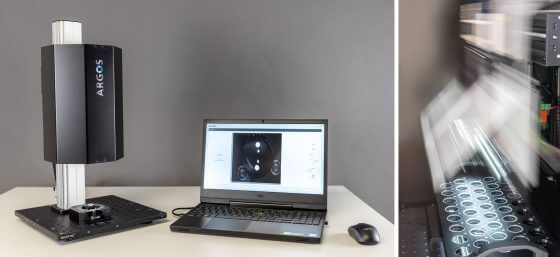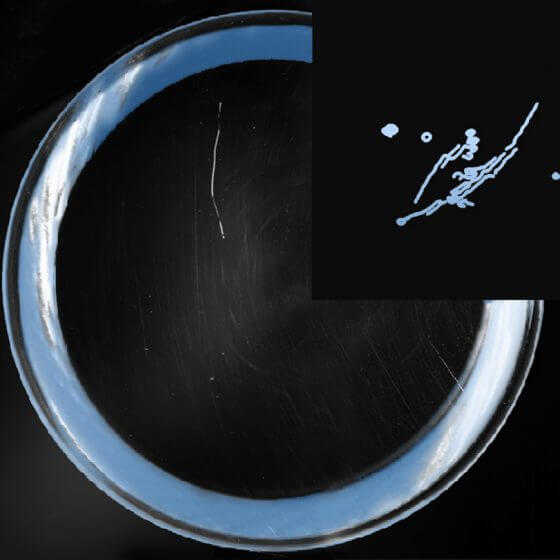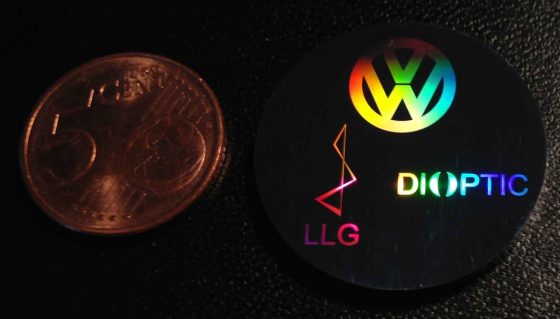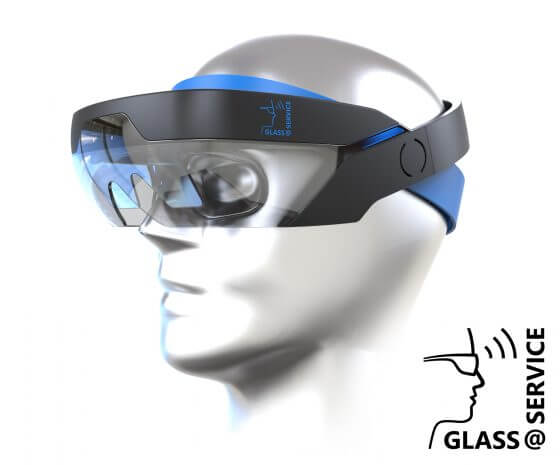Research projects
In addition to providing consultancy, services and products, DIOPTIC also does its own research. Our employees’ experience and advanced scientific education offer the potential for innovation. We utilize this potential for our own technology developments as well as for funded development.

OF-Inspector: Measuring device for detection and differentiation of surface defects
Project goal:
The aim of the project is the development of a fast and uncomplicated measuring device for the determination and differentiation of surface imperfections on optical surfaces. For this purpose, the existing ARGOS device will be extensively extended. In particular, different measuring methods (such as dark field and bright field) are to be combined to enable a better detection and differentiation of defects and particles. Advanced image processing algorithms will also contribute to this.
The main components of the ARGOS system are the acquisition unit, illumination unit and part holder. For the acquisition unit an increase of the resolution is desired. For the illumination unit, multi-modal concepts are investigated that combine information from several illumination methods. The part holder will be extended so that many parts can be tested automatically.
Results:
In addition to comprehensive software extensions for the entire ARGOS family, the funded project has resulted in the product ARGOS matrix in particular: an automated system for the serial inspection of optical elements. The particular benefit lies in the objective and reproducible testing with complete, digital documentation. The modular system can be flexibly adapted to customer requirements and has a significantly higher degree of automation than its predecessor.
Do you have a specific application for surface inspection?
We look forward to hearing from you.
For more information, please contact: Sales-Team | Tel.: +49 6201 960 90-20

Standardized surface inspection: Scratch-Dig measuring station
Project goal:
The goal of this research project is to come up with an automated inspection of optical cleanliness or ‘surface imperfections’, as they are called in the norm. Optical components today are still inspected manually (visually) for errors by optics inspectors. This project aims to achieve an automated inspection based on image processing, allowing for a norm-based classification according to ISO 10110‑7, with a corresponding automated inspection documentation.
The intention is to quantify surface imperfections of lenses and optical flats. Lenses with different radii of curvature will be measured according to the same set-up. The lighting situation will be adjusted to take into account the strong angle dependency of the scattered light in polar and azimuth angles. A software-based concept will be developed in order to differentiate dust and scratches. The aim is to achieve testing cycles of under 10 seconds.
Results:
This research product resulted in the product ARGOS, an automated surface-inspection device that offer many different opportunities for use. Its unique advantages include the speed of the inspection, the reliability of testing results, and a seamless documentation of the inspection.
Do you have a concrete application relating to surface inspection?
We hope you’ll get in touch with us about it.
For more information, please contact: Sales Team | Tel.: +49 6201 960 90-20

Fraud-proof laser labeling: holomark
Project goal:
The German Ministry for Education and Research (BMBF) is supporting the network project Holo-Mark II. The goal is to develop the world’s first unique holographic laser scanner that can be used for any laser source, from UV femtosecond lasers to infrared-fiber lasers.
Just as with a classic laser scanner, diffractive scripts and complex holographic security features will be written directly on any kind of surface (but above all metals, semiconductors and hard coatings) at a high quality and speed and customisable for each work piece.
Holographic markings based on diffractive micro and nano structures offer, among others, excellent possibilities for a forgery-proof, coded labeling. Also, from a design-technical standpoint, they are attractive in serving as an optically conspicuous and high-value feature. At the core of the Holo-Mark system is a multi-DOE interferometer for the purpose of generating a holographic wavefront, which can be customised for the process. DIOPTIC is responsible for the conceptual design, layout and implementation.
The optical system is made up of transmissive phase elements, which are designed with a high diffraction efficiency of selected orders and a strong suppression of the zero order. Periodic structures in the micro- and nanometer range can be directly written to metallic work pieces or complex-shaped injection moulding tools by creating an interference pattern using two optical grids. One grid serves as a beam splitter and the other as a beam combiner.
For more information, please contact: Dr. Frank Weidner | Tel.: +49 6201 650 40-17

Glass@Service: Augmented Reality for industrial usage
Project goal:
In the Glass@Service project, we are researching how smart data glasses can be used to create an interactive, personalized visualization of information in an industrial setting. Such Augmented Reality glasses would allow “hands-free“ interactions between the person wearing the glasses and the industrial back-end systems, thereby providing the user with information directly into his visual field, without distracting the user from important tasks.
The system solution that will be developed as part of the glass@service project network should make it possible to work in the future with powerful and inexpensive OEM modules on the market, which provide customized performance for head-mounted displays – a growing market – and also support the demands of visualized real-time services on demand in different industrial settings.
The commercial solutions that are currently available do not fulfill the special requirements in industry. Such requirements include sufficient ergonomics and battery life when carrying the glasses during an eight-hour shift, but in particular a secure connection to the industrial back-end systems and compliance with workplace and data privacy regulations.
DIOPTIC will work on the design and technology principles which will be used to implement an innovative optical image-rendition in combination with optics sensors that can be integrated for a gesture-based system control. This should make it possible, from a conceptual point of view, to build the relevant modules under cost-efficient conditions.
DIOPTIC is working on developing an augmented reality solution that fulfills these unique requirements in a project consortium that also includes Siemens, Uvex, Ubimax, the Fraunhofer Institute FEP, and the German Federal Institute for Workplace Safety and Workplace Medicine.
Glass@Service is being supported as part of the public funding program “Smart Service World” from the German Ministry for Economy and Energy.
Results:
As planned, several prototypes of binocular augmented reality glasses were built and successfully tested in an industrial environment. The very good image quality of the optical modules developed by DIOPTIC, together with the HD-OLED micro displays of the Fraunhofer Institute FEP, allows for great augmented/mixed reality visualizations.
For more information, please contact: Dr. Daniel Kiefhaber | Tel.: +49 6201 650 40-09